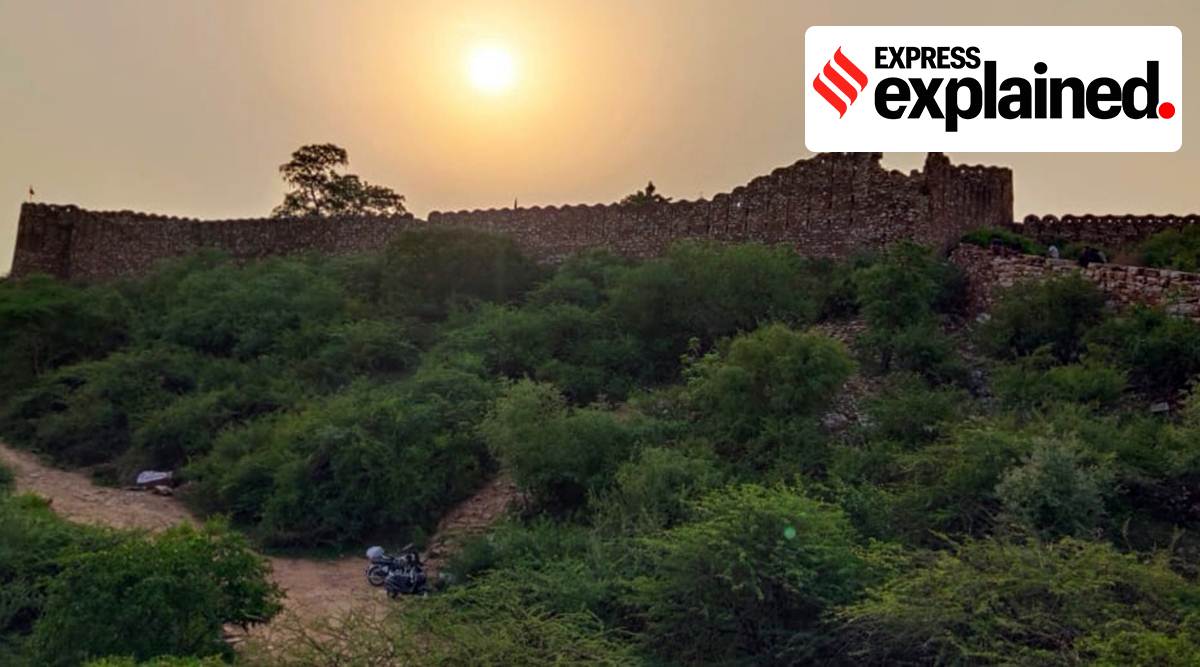Members of the Meena community say the Amagarh Fort was built by a Meena ruler predating Rajput rule in Jaipur, and has been their holy site for centuries.
A fort in Jaipur is at the centre of a conflict between the tribal Meena community and local Hindu groups. Both sides have filed police cases and are running social media campaigns to assemble at the fort and show their strength.
What is the dispute?
Members of the Meena community say the Amagarh Fort was built by a Meena ruler predating Rajput rule in Jaipur, and has been their holy site for centuries. Independent MLA Ramkesh Meena said people from the community used to worship Amba Mata and other deities in the fort.
In June, following reports of idols being vandalised and hoisting of a saffron flag at the fort, Meena community members accused Hindu groups of trying to appropriate tribal symbols into the Hindutva fold, and of changing the name of Amba Mata to Ambika Bhawani.
On July 21, the saffron flag was brought down, and a video of it getting torn in the process went viral on social media. Hindu groups have accused Meena community members of tearing the flag in presence of Ramkesh Meena, while the MLA and other Meena leaders have said that the Hindu groups had agreed to take down the flag after discussions, and that it got accidentally torn while members of Hindu groups were bringing it down.
A Brahmin group too has joined the debate. At a press conference on Thursday, Brahmin Mahasabha president Suresh Mishra, who once contested an election on a Congress ticket, said Ambika Bhawani near the fort belongs to a family of priests conducting rituals here for generations.
What is the history of the fort?
According to historian Rima Hooja, the present form of the Amagarh Fort was given in the 18th century by Maharaja Sawai Jai Singh II, founder of Jaipur. “It has always been believed that there was some construction at the place before Jai Singh II built the fort,” she said.
Prior to Rajput rule by the Kachhwaha dynasty, Jaipur and its nearby regions were ruled by Meenas, who had political control, she said. She stressed the need for a detailed documentation of the history of the Meena community, now largely oral.
Dr Heera Meena, former assistant professor in Delhi University and a scholar in tribal culture, said the fort was built by a Meena Sardar from the Nadla gotra, now known as Badgoti Meenas. “Sardars from the Meena community ruled large parts of Rajasthan till around 1100 AD,” she said.
She added that Amba Mata is different from Ambika Bhawani. “Like other tribal groups, Meenas too worship ancestors. Amba Mata was such an ancestor, a living person and not a god. Amba Mata is not related to Ambika Bhawani or Durga. An effort is being made by Hindu organisations to appropriate Amba Mata as Ambika Bhawani,” she said.
What are the police cases filed?
Three FIRs have been registered so far. In June, an FIR at the Transport Nagar police station alleged vandalism and theft of idols. According to ACP Adarsh Nagar Neel Kamal, police detained a group of juveniles from the Muslim community. After the saffron flag was brought down, both sides registered FIRs under IPC section 295 (Injuring or defiling place of worship with intent to insult the religion of any class) and sections of the IT Act.
Meena community members have maintained that there was “no Hindu-Muslim angle” to the idols being vandalised. MLA Ramkesh Meena has blamed “extreme elements” from Hindu outfits who “wanted an excuse to enter the fort and try to give a communal colour to the incident”.
Why does the Meena community matter in Rajasthan?
The community has substantial clout. Of the 25 Assembly seats (out of 200) reserved for Scheduled Tribes, most are represented by Meena MLAs from both the Congress and BJP. The community is also well represented in the bureaucracy. According to Census 2011, STs constitute 13.48% of the state’s population. Due to a scattered population across the state, the community can influence election outcomes in unreserved seats, too.
Where is the face-off headed?
After videos of the saffron flag being pulled down went viral, supporters of Hindu groups started a hashtag campaign on Twitter, demanding the arrest of Ramkesh Meena. Tribal and Dalit leaders, including Bhim Army chief Chandra Shekhar Azad, have come out in support of the Meenas.
In a social media campaign, Hindu groups said they will hoist a saffron flag on the fort on August 1, and Meena community members said they will stop any such effort. The Jaipur police have said the fort and its adjacent areas belong to the Forest Department and nobody would be allowed to assemble there.
“The majoritarian section of the population tries to distribute their symbols in such a way that the other sections will become a part of it. We can see this when Hindu groups try to assimilate tribal symbols,” said Rajeev Gupta, former professor of sociology, University of Rajasthan.
Source: Read Full Article


